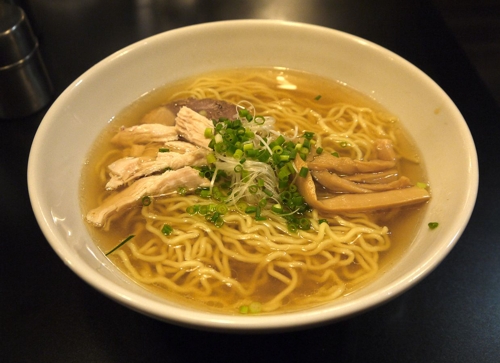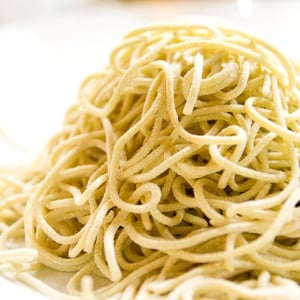Yes, you can make your own Ramen noodles It’s easy and they taste so much better than re-hydrated factory-made noodles! Success hinges on one key ingredient and it’s probably something you’ve never heard of before. Don’t feel small: I didn’t know about it, either…
 Traditional Japanese Ramen Soup with Chicken Strips, Tofu and a garnish of Scallions.
Traditional Japanese Ramen Soup with Chicken Strips, Tofu and a garnish of Scallions.
You can use virtually any combination of Vegetables and Proteins you want
as long as you concoct a complementary-flavoured Broth!
We all know Ramen noodles in their classic presentation: The ubiquitous pre-packaged Noodle Bowls some of us bought by the case to get us through those long nights cramming at college. But it’s easy to make your own as the base for a near infinite selection of soups and other Asian dishes. You’ll find home-made fresh Ramen noodles taste much better and have a much more pleasant texture than store-boiught dried ones!
What you need
You’ll need only three ingredients: Water, Flour and Alkali Water.
The Water can be straight from the tap. But filtered is better, in my experience.
I like Bread Flour rather than All Purpose. It has more gluten and that’s what makes the Noodles flexible and stretchy.
The final ingredient, Alkali Water, is something special but it’s available in all Asian Supermarkets. It helps make the Noodle dough strong while maintaining its flexibility. If you’re going the traditional route, making classic Pulled Noodles, you’ll really appreciate this quality in your Dough. Alkali Water goes by the name Kansui in Asian supermarkets. It’s named for Lake Kan in China, an alkali lake where the noodles were first made, using it’s water.
What you do
How much Ramen do you want to make? You can feed four royally with a batch containing 2 cups Flour, 1/2 cup Water and just one measuring teaspoon if Kansui. Yes that small amount will make a big difference in your Ramen. I fact, it’s what will make them real Ramen Noodles.
If you’re going to hand-pull the noodles, you’ll want a wetter, more pliable Dough. But I won’t dwell on that option; if you already know how to pull Ramen and Udon Noodles, you already know how to prepare the Dough! And hand-pulling Udon is a hard enough skill to master. Pulling thin, delicate Ramen by hand is all the more daunting!
Add the Water and Kansui to the Flour in a large bowl and combine with the handle of a wooden spoon. You’ll get a nice, firm yet elastic Dough. When it comes together, take it out onto a floured board and knead with your hands for at least five minutes. It should become somewhat more elastic. let the Dough rest for a few minutes while you get out the pasta machine. Roll out your pasta sheet to about No. 3 thickness.
I often say you don’t really need a pasta roller for most Italian pastas, Just flour it well and roll up loosely and cut across the roll with a sharp knife. That’s great for Linguini, Fettuccini, Papardelle and Farfelle. But it’s too picky for Spaghetti and Spaghettini. Also, Ramen. So I fall back on the Spaghettini cutter attachment for my pasta machine and cut my Ramen with that. Nice and even and consistent in width every time.
Now what?
You can now use your fresh Ramen noodles as the base for any number of Asian soups and Noodle dishes. Just remember, have all the other ingredients cooked before you add the Ramen Noodles. They’ll cook in under two minutes in boiling Water or really hot Soup!
Have fun!
~ Maggie J.

